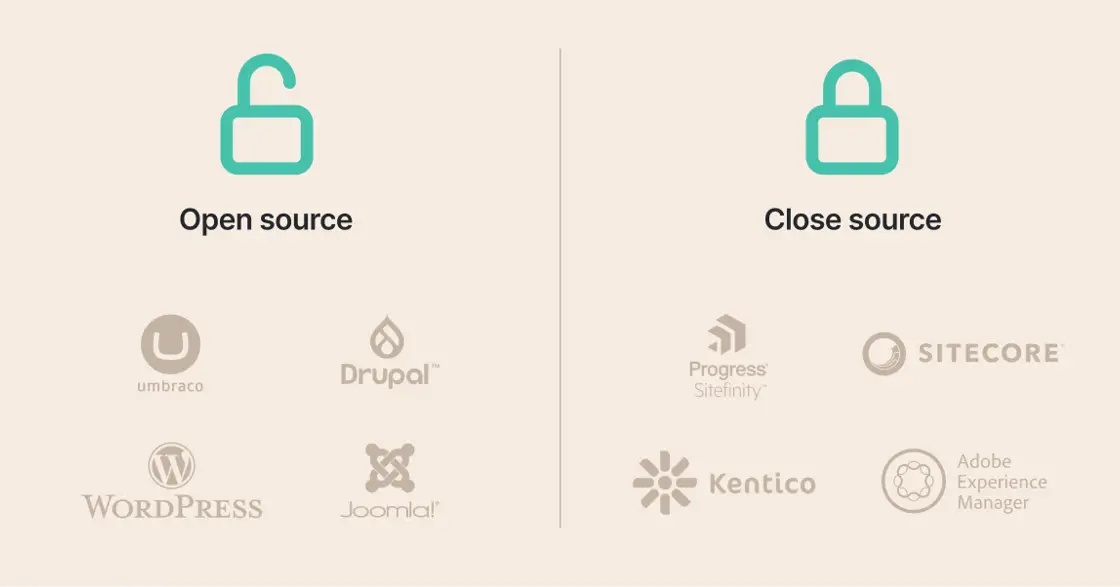What to consider when choosing a CMS

Content Management Systems form the backbone of most websites, so it's important you choose the right one.
A content management system, or CMS, is a platform to enable you to easily publish web content from a simple dashboard interface. There are literally hundreds of CMS options available, so it can be very difficult to make any choice at all, let alone the right one!
Key Takeaways
- Open-source systems are free, offer flexibility, be comparatively feature-poor, and have usability issues
- Closed-source systems are well-funded, offer more features and have high security but may be costly
Even web developers debate amongst themselves about the pros and cons of various systems, with the biggest divide falling between the open-source solutions and proprietary closed-source ones.
To break it down, open-source systems are built with the source code made available to the whole community of developers to extend and add on to the product’s original design. On some occasions, a commercial organisation will back the product and offer paid services for ongoing support. Systems such as Drupal, WordPress, Umbraco and Joomla are open-source.
Closed-source systems are built by a company that packages it up and sells it to you with a one-off or ongoing license fee. These packages offer support services, different pricing tiers, product training and assistance with future upgrades. Some of the more popular closed-source systems include Sitecore, Sitefinity, Kentico and Adobe Experience Manager.
So which way should you go? We’ve compiled the pros and cons to consider.
The pros of open-source
Evolving marketplace. The involvement of communities of developers to extend and supply plugins for the system means someone somewhere would have likely built something similar to what you want already, which you can reuse.
Cost. Open-source licenses are free. If your budget is tight and the thought of ongoing license fees is out of the question, then this is clearly a significant benefit.
Flexibility. If you have the know-how or enough development budget, you could make the system do whatever you want.
The open-source cons
Security concerns. Because there is no review process for plugins and extensions, there are no guarantees of 100% security. Essentially, you are trusting that a developer somewhere is good at what they do. WordPress, for example, is the most popular CMS on the planet and is also the most hacked.
Comparatively feature-poor. These free systems are in a constant game of catch-up to the big boys in terms of the latest and greatest features. Unfortunately, without the research and development budgets, they just can't compete here.
Usability. This one may ignite some arguments, but following on from the above point, without the big budgets of closed systems, open-source systems generally aren't as straightforward and obvious to use, nor as pretty. Be prepared for forms-based content editing.
The pros of closed-source
Well-funded. For a commercial endeavour to succeed, the product needs to be reliable, usable, well-priced and supported by good service. These companies have development and design teams working day in, day out to build a stable platform and continually improve it.
Feature rich. Most proprietary products have more features than their open-source counterparts. Examples include in-page editing, analytics, in-built marketing, personalisation and more.
High security. Security is a major priority for these products where reputation and valuable data are on the line. If a hole in security can be detected, these companies build a patch with break-neck speed.
The closed-source cons.
Cost. This is a big one for some. Depending on the system and feature level, decent proprietary systems can cost from $2,000 to $200,000 plus.
Hosting and support. These costs are typically higher than the open-source alternatives. Naturally, the bigger the system and the more features it has, the more resources it requires to run. This can vary but you may be looking at a multi-server setup with the complexity and costs associated.
Flexibility. A closed system does not mean it can't be extended or customised, in fact, far from it. But there may be parts of the system that aren't as easy to change. Also, finding a partner to take over development may be harder due to the learning curve for the developers.
Still undecided?
There is clearly an argument for both sides, so how can anyone make a decision?
The process equ takes to advise a client is this:
-
Create a list of functional and non-functional requirements for your website including things like Ease of Use, Blog modules, Image Galleries etc.
-
Prioritise this list of requirements using the MosCoW method (Must have, Should have, Could have, and Won't have).
-
Give a weighting score to each of the priorities.
-
Choose a shortlist of CMS frontrunners that fit your technology requirements or may have been recommended, and then download the demos to try them out. At this point, you are only doing a high level selection to build up a shopping list.
-
Get a CMS expert to score how each CMS meets your requirements.
-
Calculate the final score and you should in theory come out with a clear winner.
-
If the scores remain too close to clearly choose a winner, you may have to choose a couple of very important features to use as the tie breaker.
Our experience is that no one CMS will do absolutely everything you want it to do out of the box, so it’s worth reserving some budget to have an experienced developer customise the CMS for your purposes.
At Equilibrium, we work with a number of content management systems, but the two that we put up against each other the most are Sitefinity and Umbraco. Both of these systems are based on the Microsoft.Net platform but they have varying technology, licensing models and feature sets.
Selecting the right CMS can be daunting. If you need some guidance to choose the one best suited to your business, we can help. Contact us today.




